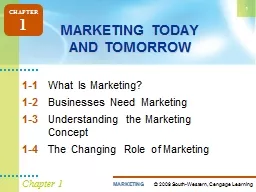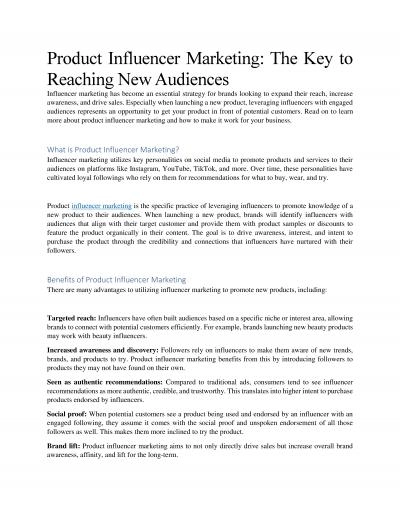Chapter 1: New Perspectives On Marketing in the
Author : faustina-dinatale | Published Date : 2025-06-23
Description: Chapter 1 New Perspectives On Marketing in the Service Economy Overview of Chapter 1 Why Study Services What are Services Marketing Challenges Posed by Services Extended Marketing Mix Required for Services Integration of Marketing with
Presentation Embed Code
Download Presentation
Download
Presentation The PPT/PDF document
"Chapter 1: New Perspectives On Marketing in the" is the property of its rightful owner.
Permission is granted to download and print the materials on this website for personal, non-commercial use only,
and to display it on your personal computer provided you do not modify the materials and that you retain all
copyright notices contained in the materials. By downloading content from our website, you accept the terms of
this agreement.
Transcript:Chapter 1: New Perspectives On Marketing in the:
Chapter 1: New Perspectives On Marketing in the Service Economy Overview of Chapter 1 Why Study Services? What are Services? Marketing Challenges Posed by Services Extended Marketing Mix Required for Services Integration of Marketing with Other Management Functions Developing Effective Service Marketing Strategies Why Study Services? Why Study Services? Services dominate most economies and are growing rapidly: Services account for more than 60% of GDP worldwide Almost all economies have a substantial service sector Most new employment is provided by services Strongest growth area for marketing Understanding services offers you a personal competitive advantage Services Dominate the Global Economy Contribution of Service Industries to GDP Globally Source: The World Factbook 2008, Central Intelligence Agency Services 64% Agriculture 4% Manufacturing 32% Why Study Services? Most new jobs are generated by services Fastest growth expected in knowledge-based industries Significant training and educational qualifications required, but employees will be more highly compensated Will service jobs be lost to lower-cost countries? Yes, some service jobs can be exported Why Study Services? Powerful forces are transforming service markets Government policies, social changes, business trends, advances in IT, internationalization Forces that reshape: Demand Supply The competitive landscape Customers’ choices, power, and decision making Transformation of the Service Economy Success hinges on: Increased focus on services marketing and management Factors Stimulating Transformation of the Service Economy Factors Stimulating Transformation of the Service Economy Rising consumer expectations More affluence More people short of time Increased desire for buying experiences vs. things Rising consumer ownership of high tech equipment Easier access to information Immigration Growing but aging population Government Policies Factors Stimulating Transformation of the Service Economy Push to increase shareholder value Emphasis on productivity and cost savings Manufacturers add value through service and sell services More strategic alliances and outsourcing Focus on quality and customer satisfaction Growth of franchising Marketing emphasis by nonprofits Government Policies Factors Stimulating Transformation of the Service Economy Growth of Internet Greater bandwidth Compact mobile equipment Wireless networking Faster, more powerful software Digitization of text, graphics, audio, video Government Policies Factors Stimulating Transformation of the Service Economy More companies operating on transnational basis Increased international travel International mergers and alliances “Offshoring” of customer service Foreign competitors invade domestic markets Government Policies What are Services? What Are Services? The historical view Smith (1776): Services are different from goods because they are perishable Say (1803): As services are immaterial, consumption cannot be separated from production A










![[READ]-New Perspectives on Blended HTML, XHTML, and CSS: Introductory (New Perspectives](https://thumbs.docslides.com/992026/read-new-perspectives-on-blended-html-xhtml-and-css-introductory-new-perspectives-series-web-design.jpg)



